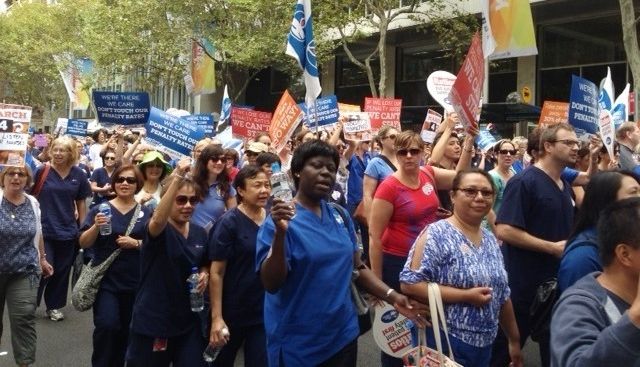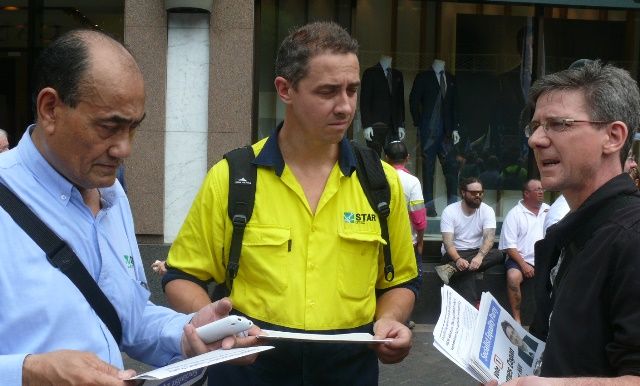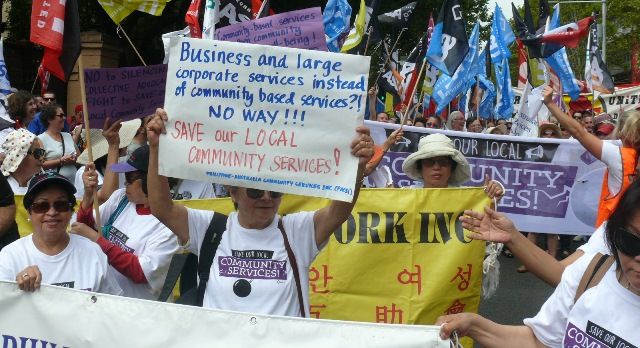Kate Randall
The US Supreme Court heard oral arguments Wednesday in a case challenging the provision of subsidies to purchase health care insurance under the Affordable Care Act (ACA) in at least 34 US states. The Court is expected to deliver its ruling in late June.
A ruling favoring the plaintiffs could cripple the law popularly known as Obamacare by causing up to 7.5 million people to lose the tax subsidies that help them purchase health care coverage on the federal exchange set up under the ACA.
At issue is a four-word phrase in the 900-page ACA legislation, which reads that subsidies are available to those buying insurance on exchanges “established by the State.” Only 13 states and the District of Columbia fully operate their own exchanges. The federal government controls 34, and three states that originally established exchanges later turned over enrollment to federal authorities.
The Obama administration contends that in the context of the law’s language the subsidies are available for those purchasing coverage on the federal exchange, not just the state exchanges.
Under the “individual mandate” of the ACA, those who are not insured through their employer or through a government program such as Medicare or Medicaid must obtain insurance. This provision forces individuals and families, under threat of substantial tax penalties, to purchase health insurance from private insurers on the Obamacare exchanges.
The suit before the high court, King v. Burwell, is financed by the Washington-based libertarian group Competitive Enterprise Institute. The plaintiffs, four residents of Virginia, one of the states utilizing the federal exchange, argue that they do not want to buy health insurance. If not for the subsidies, they would qualify for an economic hardship exemption from the tax penalty for failing to obtain health insurance—thus they would be able to not purchase insurance and not have to pay a penalty.
Two federal appellate courts have heard challenges to the subsidies. The D.C. Circuit ruled 2-1 in favor of the plaintiffs, and the Fourth Circuit ruled 3-0 in favor of the government. The Supreme Court will resolve the disagreement between the circuits.
This is the third major suit challenging aspects of the ACA brought before the high court. The court ruled 5-4 on June 28, 2012, to uphold key provisions of the health care legislation, including the reactionary individual mandate, while ruling that the federal government could not force states to expand Medicaid by withdrawing existing funding for the health care program for the poor.
In a 5-4 ruling striking a blow against First Amendment rights on June 30, 2014, the Court held that private corporations can deny their workers insurance for birth control, coverage otherwise required under the ACA, as long as the corporate owners claim their religious beliefs oppose contraception.
On Wednesday, the nine Supreme Court justices heard 85 minutes of arguments in King v. Burwell. Justice Anthony Kennedy, a conservative who often casts the deciding vote in close cases, raised concerns to lawyers on both sides about the possible negative impact on states if the Court rules against the government.
Addressing Michael Carvin, attorney for the plaintiffs, Kennedy asked whether, in the event that the subsidies were invalidated, the states would be told “either create your own exchange, or we’ll send your insurance market into a death spiral.” Lacking the subsidies, most of the 7.5 million people previously qualifying for them could not afford coverage. Without enough paying customers, the health insurers’ profit margin would be hit by the costs of insuring those who under the ACA can now buy insurance regardless of preexisting conditions.
While voicing some reservations about the challenge, Kennedy also said he was concerned by how the administration had implemented the law. He did not, however, make clear how he would rule in this case. Chief Justice John Roberts, who provided the key vote in the ruling upholding the ACA in 2012, said little to signal how he might vote.
The four “liberals” on the court—Justices Ruth Bader Ginsburg, Stephen Breyer, Sonia Sotomayor and Elena Kagan—all appeared supportive of the Obama administration during questioning. Their statements were motivated in the main by the desire to uphold the pro-corporate character of Obamacare and fear that knocking down the subsidies would threaten the entire enterprise with collapse.
Breyer asked Carvin about the effect on the ACA more broadly if the language, “established by the State,” were interpreted to mean only state-based exchanges. Based on that reading, he suggested, no one in a federal exchange would be considered “qualified” to buy coverage. Kagan alluded to the possibility that “there will be no customers and, in fact, there will be no products” on the exchange.
Ultra conservatives Antonin Scalia and Samuel Alito asked questions generally sympathetic to the plaintiffs. In keeping with prior performances, Clarence Thomas had nothing to say. Alito asked Solicitor General Donald Verrilli, representing the Obama administration, whether the ACA might be rendered unconstitutionally coercive if it forced states to either set up exchanges or deny benefits to its citizens.
Verilli responded that this was “another very powerful reason to read the statutory text our way” and that the plaintiffs’ restrictive view of who should receive subsidies would render the ACA “an incoherent statute that doesn’t work.” He also warned the Court that a ruling for the plaintiffs would have disastrous consequences, causing premiums to skyrocket and plunging many states’ individual insurance markets into chaos.
Scalia replied, “What about Congress? You really think that Congress is just going to sit there while all of these disastrous consequences ensue?” Republican Congressional leaders, in fact, have worked to convince the Court that they would come up with a remedy in the event that the justices rule against the subsidies.
Republican Sen. Orrin Hatch of Utah and Rep. Paul Ryan of Wisconsin—who were present in the courtroom—both recently published op-eds saying they would propose a fix allowing people to keep their coverage, possibly including a temporary extension of the Obamacare subsidies, if the Court rules against the subsidies.
The Republicans’ opposition to Obamacare from the right, and their posturing as the defenders of citizens’ rights against “big government” intervention into their health care decisions, is only possible due to the thoroughly reactionary character of Obama’s signature health care “reform.”
Among other notables present at Wednesday’s oral arguments were House Minority Leader Nancy Pelosi (Democrat of California), Health and Human Services Secretary Sylvia Burwell and former HHS secretary Kathleen Sebelius, who presided over the botched rollout of the HealthCare.gov web site. Leading Democrats fear a ruling for the plaintiffs in King v. Burwell would threaten a further unmasking of the Obama administration’s chief legislative achievement.
That Obamacare could be upended by the Supreme Court decision underscores the fact that the entire program is predicated on and subordinated to the profit interests of the giant insurance companies, who have control over who is insured and what they must pay for coverage.
This is an essential feature of the administration’s principal domestic initiative: a reactionary piece of legislation aimed at cutting costs for big business and the government, boosting the profits of the health care industry, rationing health care for the vast majority of ordinary Americans, and promoting an even more heavily class-based health care system.







